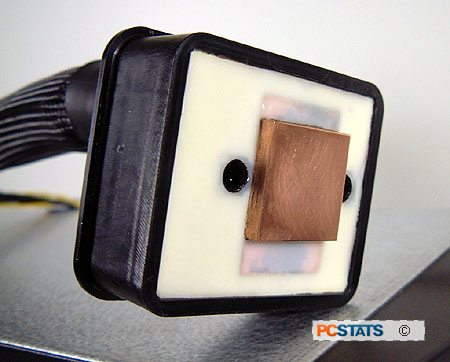A phase change cooling system like the Prometeia Mach II
GT essentially works like this: the compressor pressurizes a gaseous refrigerant into liquid
form, which causes it to rise in temperature. The liquid refrigerant is
sent to the condenser (a heat exchanger) where it is cooled
down.
The liquid refrigerant is then forced at high
pressure through copper capillary tubing into an evaporation chamber, which is a
low pressure area. There it evaporates (changes from from liquid to gas) back
into gaseous form and absorbs latent heat in an endothermic reaction. The now
heated gas is then pumped back into the compressor to be turned into a liquid
before proceeding to the condenser again to dump its heat.

The evaporation chamber in a phase-change cooling system like the
Prometeia Mach II GT happens to be the block of copper which is attached to the
CPU. As the chamber decreases in temperature, it absorbs the heat energy from the
processor below it, lowering the chip's overall temperature as well.
Acoustics, fans,
pumps, and just how loud is a phase change cooler?
Despite
what you may assume, a phase change cooler which comprises of a
refrigerator-style compressor and pair of DC cooling fans, is not loud. When
the Prometeia Mach II GT is first turned on, the compressor runs at full load (which produces up
to 41dB of noise according to ECT) until the cooling head reaches its
booting temperature. Once the head hits this temperature mark the system switches to
normal operation mode (35dB) and the fans run at about 50% speed.
The
Prometeia Mach II GT can connect directly to your computer via USB, so can
also adjust the speed of the front and rear fans to increase/decrease the noise
level further still. The compressor generates a low pitched hum that anyone in
the western hemisphere is familiar with,
and so it blends nicely into the background.
Overall,
you will have a noticeably louder system with a phase change cooler running than
you would with a stock heatsink. On the other hand, it will be much
quieter than any mid-level overclocking fan on the market.
